Comparison of Cloud Properties between SGLI Aboard GCOM-C Satellite and MODIS Aboard Terra Satellite
Abstract
1. Introduction
2. Data and Study Method
2.1. Data
2.2. Study Method
- Group I: Both MODIS and SGLI sensors exist in forward scattering direction.
- Group II: Both MODIS and SGLI sensors exist in backward scattering direction.
- Group III: MODIS (SGLI) exists in forward (backward) scattering direction.
- Group IV: MODIS (SGLI) exists in backward (forward) scattering direction.
3. Results
3.1. Comparison of Cloud Phase
3.2. Comparison of Cloud Properties
3.2.1. Water Clouds
3.2.2. Ice Clouds
4. Discussions
4.1. Cloud Optical Thickness
4.2. Solar Zenith Angle
4.3. Satellite Geometries
5. Conclusions
Author Contributions
Funding
Data Availability Statement
Conflicts of Interest
References
- Ramanathan, V.; Cess, R.D.; Harrison, E.F.; Minnis, P.; Barkstrom, B.R.; Ahmad, E.; Hartmann, D. Cloud-radiative forcing and climate: Results from the Earth radiation budget experiment. Science 1989, 243, 57–63. [Google Scholar] [CrossRef]
- Rosenfeld, D.; Andreae, M.O.; Asmi, A.; Chin, M.; de Leeuw, G.; Donovan, D.P.; Kahn, R.; Kinne, S.; Kivekäs, N.; Kulmala, M.; et al. Global observations of aerosol-cloud-precipitation-climate interactions. Rev. Geophys. 2014, 52, 750–808. [Google Scholar] [CrossRef]
- Khatri, P.; Takamura, T. An Algorithm to Screen Cloud-A?ected Data for Sky Radiometer Data Analysis. J. Meteorol. Soc. 2009, 87, 189–204. [Google Scholar] [CrossRef]
- Khatri, P.; Ooashi, H.; Iwabuchi, H. Investigating Aerosol Effects on Maritime Deep Convective Clouds Using Satellite and Reanalysis Data. Sola 2020, 16, 228–232. [Google Scholar] [CrossRef]
- Platnick, S.; Meyer, K.G.; King, M.D.; Wind, G.; Amarasinge, N.; Marchant, B.; Arnold, G.T.; Zhibo, Z.; Hubanks, P.A.; Holz, R.E.; et al. The MODIS cloud optical and microphysical products: Collection 6 updates and examples from terra and aqua. IEEE Trans. Geosci. Remote Sens. 2017, 55, 502–525. [Google Scholar] [CrossRef]
- Bessho, K.; Date, K.; Hayashi, M.; Ikeda, A.; Imai, T.; Inoue, H.; Kumagai, Y.; Miyakawa, T.; Murata, H.; Ohno, T.; et al. An Introduction to Himawari-8/9–Japan’s New-Generation Geostationary Meteorological Satellites. J. Meteorol. Soc. Jpn. Ser. II 2016, 94, 151–183. [Google Scholar] [CrossRef]
- Khatri, P.; Iwabuchi, H.; Saito, M. Vertical Profiles of Ice Cloud Microphysical Properties and Their Impacts on Cloud Retrieval Using Thermal Infrared Measurements. J. Geophys. Res. Atmos. 2018, 123, 5301–5319. [Google Scholar] [CrossRef]
- Letu, H.; Yang, K.; Nakajima, T.Y.; Ishimoto, H.; Nagao, T.M.; Riedi, J.; Baran, A.J.; Ma, R.; Wang, T.; Shang, H.; et al. High-resolution retrieval of cloud microphysical properties and surface solar radiation using Himawari-8/AHI next-generation geostationary satellite. Remote Sens. Environ. 2020, 239, 111583. [Google Scholar] [CrossRef]
- Letu, H.; Nakajima, T.Y.; Wang, T.; Shang, H.; Ma, R.; Yang, K.; Baran, A.J.; Riedi, J.; Ishimoto, H.; Yoshida, M.; et al. A new benchmark for surface radiation products over the East Asia-Pacific region retrieved from the Himawari-8/AHI next-generation geostationary satellite. Bull. Am. Meteorol. Soc. 2021, 103, 1–40. [Google Scholar] [CrossRef]
- Khatri, P.; Hayasaka, T.; Holben, B.; Tripathi, S.N.; Misra, P.; Patra, P.K.; Hayashida, S.; Dumka, U.C. Aerosol Loading and Radiation Budget Perturbations in Densely Populated and Highly Polluted Indo-Gangetic Plain by COVID-19: Influences on Cloud Properties and Air Temperature. Geophys. Res. Lett. 2021, 48, e2021GL093796. [Google Scholar] [CrossRef]
- Khatri, P.; Hayasaka, T.; Irie, H.; Letu, H.; Nakajima, T.Y.; Ishimoto, H.; Takamura, T. Quality assessment of Second-generation Global Imager (SGLI)-observed cloud properties using SKYNET surface observation data. Atmos. Meas. Tech. 2022, 15, 1967–1982. [Google Scholar] [CrossRef]
- Damiani, A.; Irie, H.; Takamura, T.; Kudo, R.; Khatri, P.; Iwabuchi, H.; Masuda, R.; Nagao, T. An Intensive Campaign-Based Intercomparison of Cloud Optical Depth from Ground and Satellite Instruments under Overcast Conditions. Sola 2019, 15, 198–204. [Google Scholar] [CrossRef]
- Khatri, P.; Iwabuchi, H.; Hayasaka, T.; Irie, H.; Takamura, T.; Yamazaki, A.; Damiani, A.; Letu, H.; Kai, Q. Retrieval of cloud properties from spectral zenith radiances observed by sky radiometers. Atmos. Meas. Tech. 2019, 12, 6037–6047. [Google Scholar] [CrossRef]
- Khatri, P.; Hayasaka, T.; Iwabuchi, H.; Takamura, T.; Irie, H.; Nakajima, T.Y. Validation of MODIS and AHI Observed Water Cloud Properties Using Surface Radiation Data. J. Meteorol. Soc. Jpn. Ser. II 2018, 96B, 151–172. [Google Scholar] [CrossRef]
- Nakajima, T.; Campanelli, M.; Che, H.; Estellés, V.; Irie, H.; Kim, S.-W.; Kim, J.; Liu, D.; Nishizawa, T.; Pandithurai, G.; et al. An overview of and issues with sky radiometer technology and SKYNET. Atmos. Meas. Tech. 2020, 13, 4195–4218. [Google Scholar] [CrossRef]
- Khatri, P.; Takamura, T.; Shimizu, A.; Sugimoto, N. Observation of low single scattering albedo of aerosols in the downwind of the East Asian desert and urban areas during the inflow of dust aerosols. J. Geophys. Res. Atmos. 2014, 119, 787–802. [Google Scholar] [CrossRef]
- Khatri, P.; Takamura, T.; Shimizu, A.; Sugimoto, N. Spectral Dependency of Aerosol Light-Absorption over the East China Sea Region. Sola 2010, 6, 1–4. [Google Scholar] [CrossRef]
- Min, Q.; Joseph, E.; Lin, Y.; Min, L.; Yin, B.; Daum, P.H.; Kleinman, L.I.; Wang, J.; Lee, Y.N. Comparison of MODIS cloud microphysical properties with in-situ measurements over the Southeast Pacific. Atmos. Chem. Phys. 2012, 12, 11261–11273. [Google Scholar] [CrossRef]
- Liu, J.; Li, Z.; Zheng, Y.; Chiu, J.C.; Zhao, F.; Cadeddu, M.; Weng, F.; Cribb, M. Cloud optical and microphysical properties derived from ground-based and satellite sensors over a site in the Yangtze Delta region. J. Geophys. Res. Atmos. 2013, 118, 9141–9152. [Google Scholar] [CrossRef]
- Nakajima, T.Y.; Ishida, H.; Nagao, T.M.; Hori, M.; Letu, H.; Higuchi, R.; Tamaru, N.; Imoto, N.; Yamazaki, A. Theoretical basis of the algorithms and early phase results of the GCOM-C (Shikisai) SGLI cloud products. Prog. Earth Planet. Sci. 2019, 6, 1–25. [Google Scholar] [CrossRef]
- Nakajima, T.; King, M.D. Determination of the Optical Thickness and Effective Particle Radius of Clouds from Reflected Solar Radiation Measurements. Part I: Theory. J. Atmos. Sci. 1990, 47, 1878–1893. [Google Scholar] [CrossRef]
- Platnick, S. Vertical photon transport in cloud remote sensing problems. J. Geophys. Res. Atmos. 2000, 105, 22919–22935. [Google Scholar] [CrossRef]
- Yang, P.; Bi, L.; Baum, B.A.; Liou, K.-N.; Kattawar, G.W.; Mishchenko, M.I.; Cole, B. Spectrally Consistent Scattering, Absorption, and Polarization Properties of Atmospheric Ice Crystals at Wavelengths from 0.2 to 100 μm. J. Atmos. Sci. 2013, 70, 330–347. [Google Scholar] [CrossRef]
- Baum, B.A.; Menzel, W.P.; Frey, R.A.; Tobin, D.C.; Holz, R.E.; Ackerman, S.A.; Heidinger, A.K.; Yang, P. MODIS Cloud-Top Property Refinements for Collection 6. J. Appl. Meteorol. Climatol. 2012, 51, 1145–1163. [Google Scholar] [CrossRef]
- Ishimoto, H.; Masuda, K.; Mano, Y.; Orikasa, N.; Uchiyama, A. Irregularly shaped ice aggregates in optical modeling of convectively generated ice clouds. J. Quant. Spectrosc. Radiat. Transf. 2012, 113, 632–643. [Google Scholar] [CrossRef]
- Baum, B.A.; Soulen, P.F.; Strabala, K.I.; King, M.D.; Ackerman, S.A.; Menzel, W.P.; Yang, P. Remote sensing of cloud properties using MODIS airborne simulator imagery during SUCCESS: 2. Cloud thermodynamic phase. J. Geophys. Res. Atmos. 2000, 105, 11781–11792. [Google Scholar] [CrossRef]
- Nagao, T.M.; Suzuki, K. Temperature-Independent Cloud Phase Retrieval from Shortwave-Infrared Measurement of GCOM-C/SGLI With Comparison to CALIPSO. Earth Space Sci. 2021, 8, e2021EA001912. [Google Scholar] [CrossRef]
- Tang, J.; Xue, Y.; Yu, T.; Guan, Y.; Cai, G.; Hu, Y. Aerosol retrieval over land by exploiting the synergy of TERRA and AQUA MODIS data. Sci. China Ser. D 2006, 49, 641–649. [Google Scholar] [CrossRef]
- Marchant, B.; Platnick, S.; Meyer, K.; Wind, G. Evaluation of the MODIS Collection 6 multilayer cloud detection algorithm through comparisons with CloudSat Cloud Profiling Radar and CALIPSO CALIOP products. Atmos. Meas. Tech. 2020, 13, 3263–3275. [Google Scholar] [CrossRef]
- Wind, G.; Platnick, S.; King, M.D.; Hubanks, P.A.; Pavolonis, M.J.; Heidinger, A.K.; Yang, P.; Baum, B.A. Multilayer Cloud Detection with the MODIS Near-Infrared Water Vapor Absorption Band. J. Appl. Meteorol. Climatol. 2010, 49, 2315–2333. [Google Scholar] [CrossRef]
- Nakajima, T.Y.; Nakajima, T. Wide-area determination of cloud microphysical properties from NOAA AVHRR measurement for FIRE and ASTEX regions. J. Atmos. Sci. 1995, 52, 4043–4059. [Google Scholar] [CrossRef]
- Loeb, N.G.; Davies, R. Angular dependence of observed reflectances: A comparison with plane parallel theory. J. Geophys. Res. Atmos. 1997, 102, 6865–6881. [Google Scholar] [CrossRef]
- Kato, S.; Hinkelman, L.M.; Cheng, A. Estimate of satellite-derived cloud optical thickness and effective radius errors and their effect on computed domain-averaged irradiances. J. Geophys. Res. 2006, 111, D17201. [Google Scholar] [CrossRef]
- Fu, Q.; Cribb, M.C.; Barker, H.W.; Krueger, S.K.; Grossman, A. Cloud Geometry Effects on Atmospheric Solar Absorption. J. Atmos. Sci. 2000, 57, 1156–1168. [Google Scholar] [CrossRef]
- Loeb, N.G.; Várnai, T.; Davies, R. Effect of cloud inhomogeneities on the solar zenith angle dependence of nadir reflectance. J. Geophys. Res. Atmos. 1997, 102, 9387–9395. [Google Scholar] [CrossRef]
- Liang, L.; Girolamo, L.D. A global analysis on the view-angle dependence of plane-parallel oceanic liquid water cloud optical thickness using data synergy from MISR and MODIS. J. Geophys. Res. Atmos. 2013, 118, 2389–2403. [Google Scholar] [CrossRef]
- Várnai, T.; Marshak, A. View angle dependence of cloud optical thicknesses retrieved by Moderate Resolution Imaging Spectroradiometer (MODIS). J. Geophys. Res. 2007, 112, D06203. [Google Scholar] [CrossRef]
- Loeb, N.G.; Coakley, J.A., Jr. Inference of Marine Stratus Cloud Optical Depths from Satellite Measurements: Does 1D Theory Apply? J. Clim. 1998, 11, 215–233. [Google Scholar] [CrossRef]
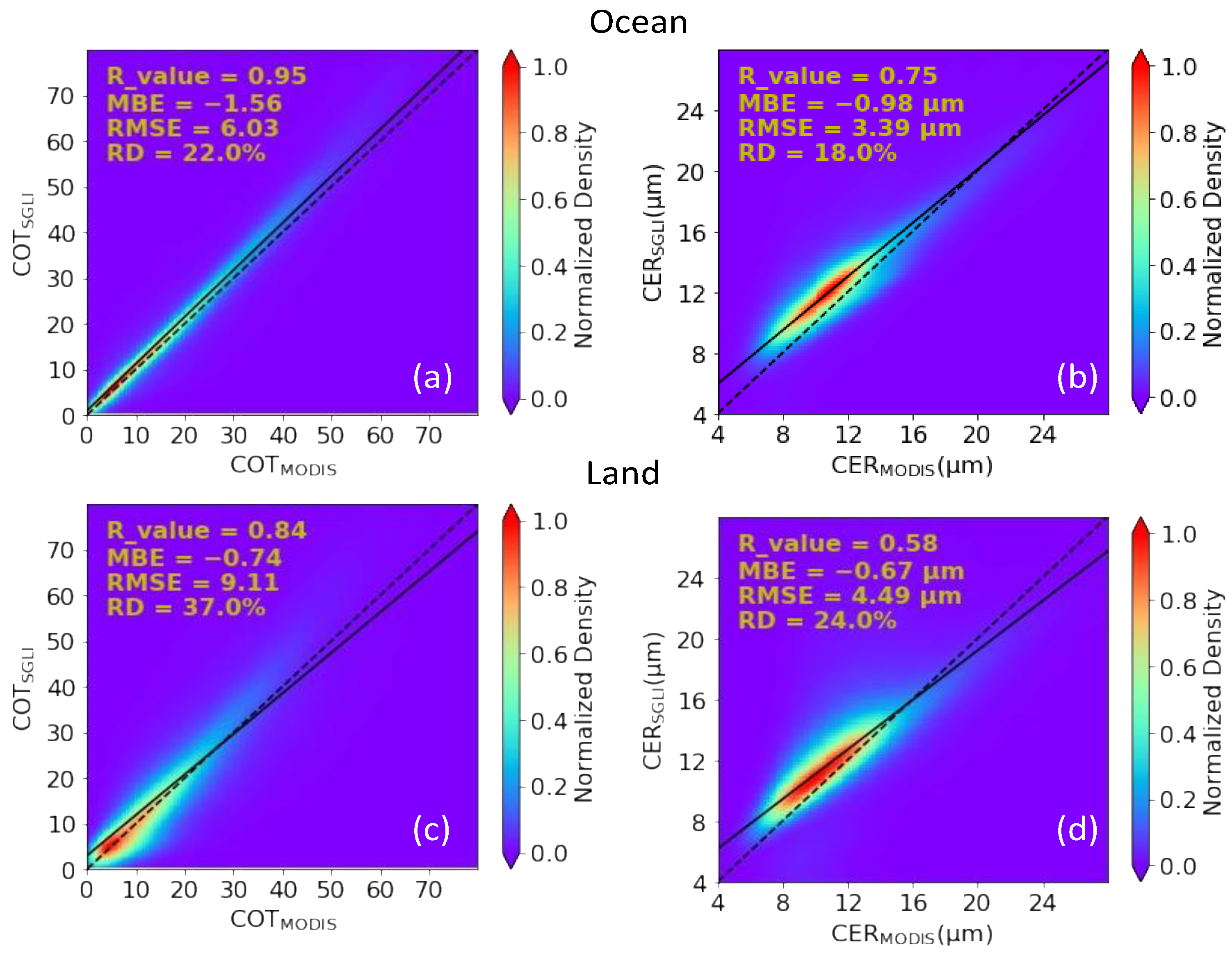
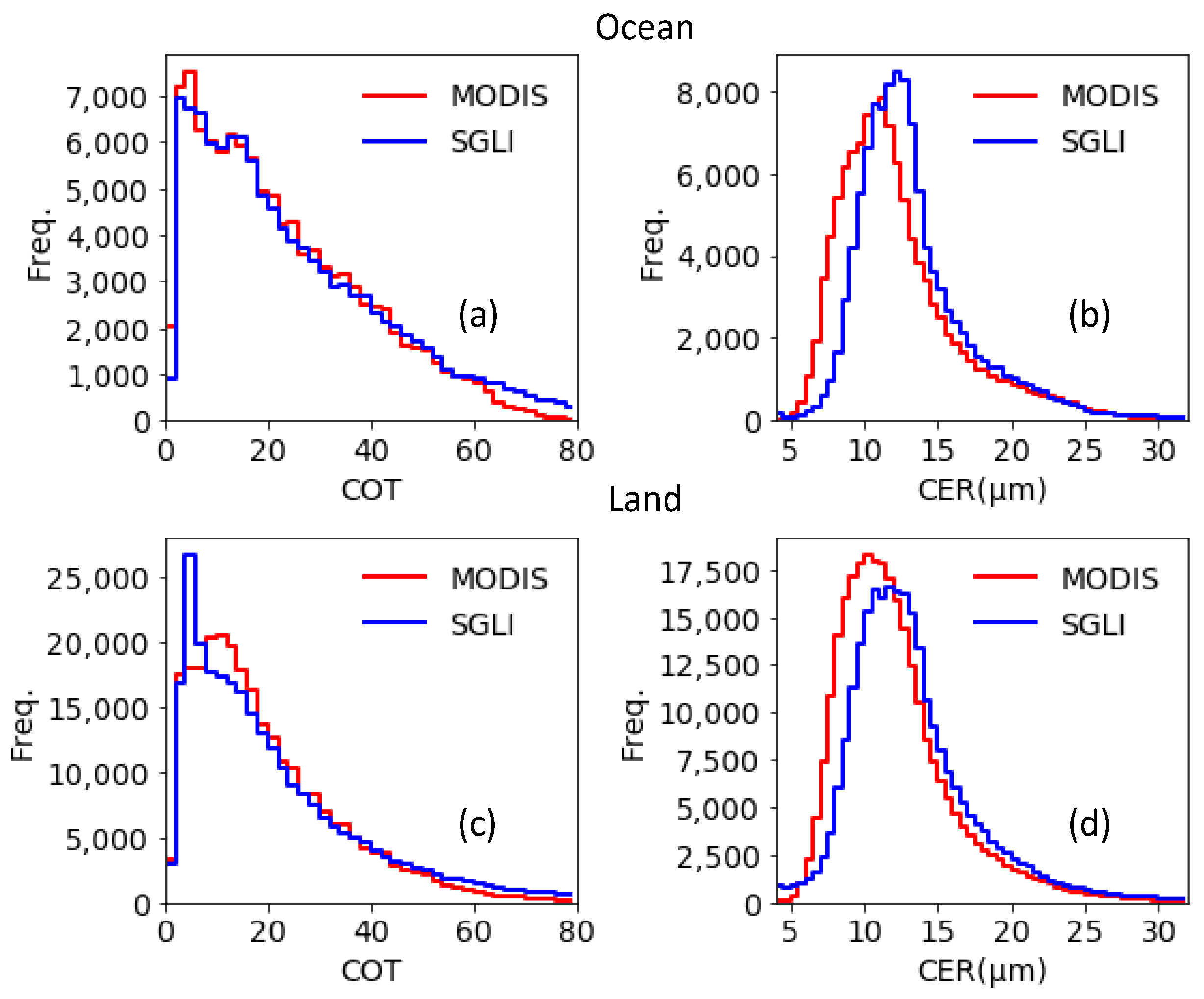
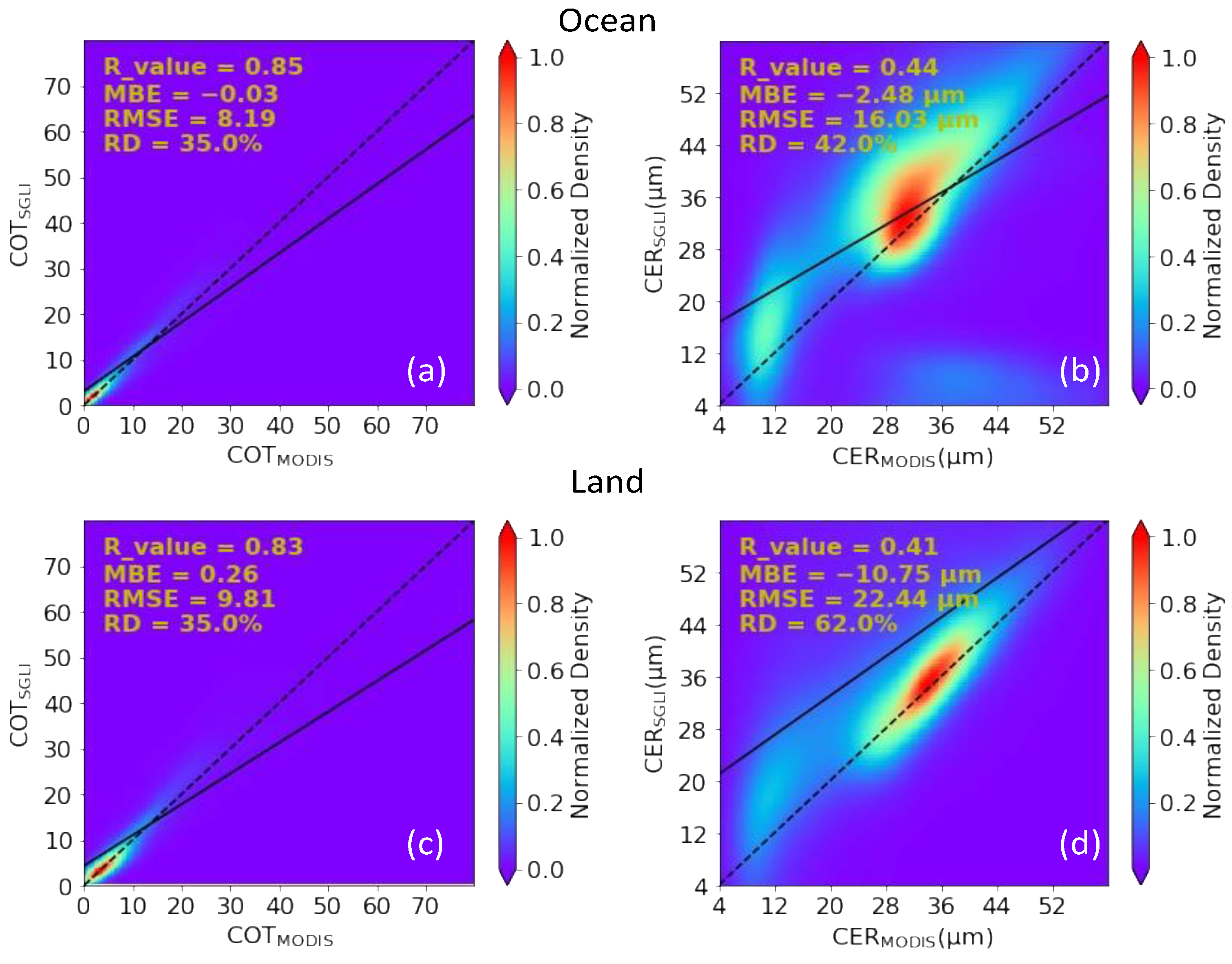
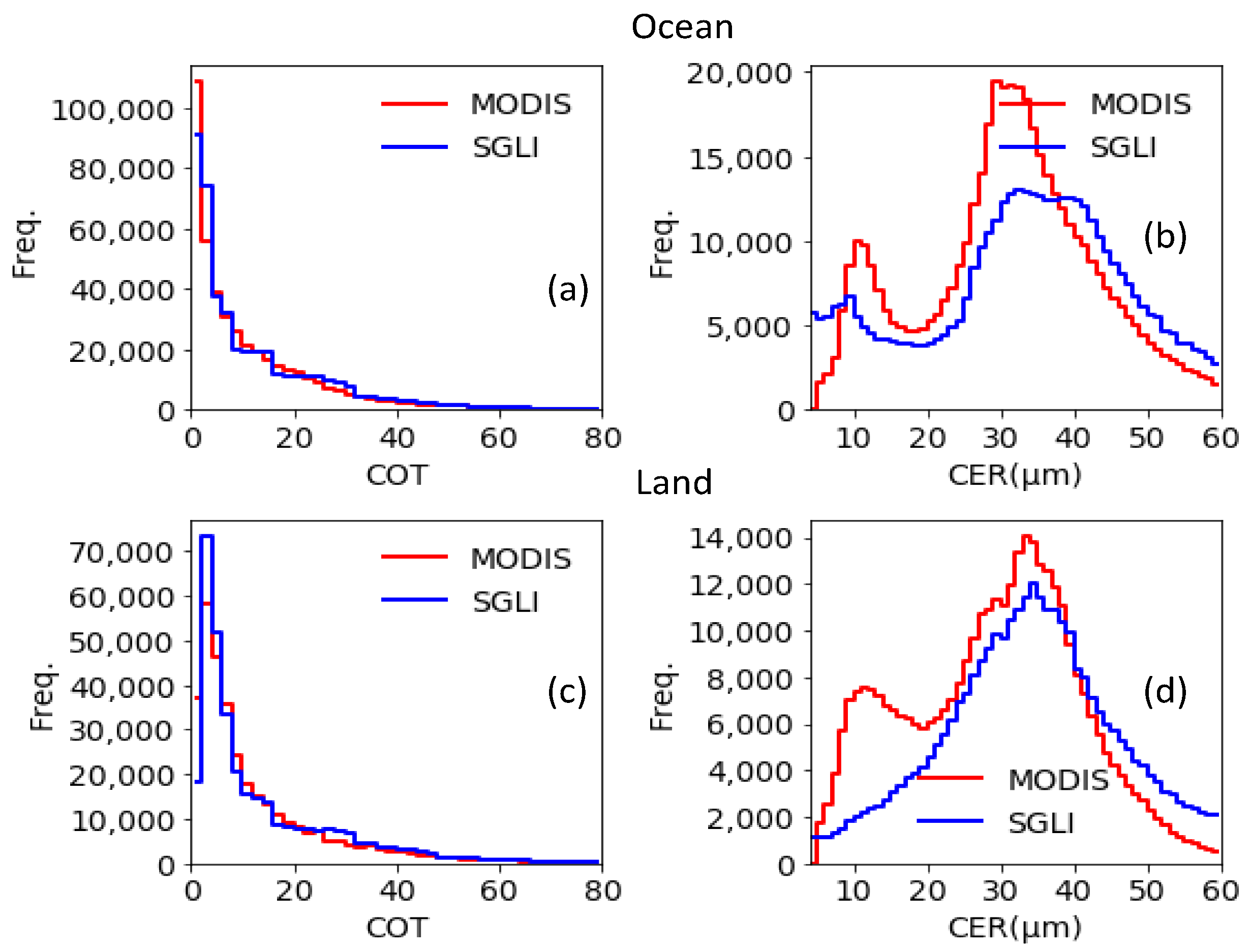
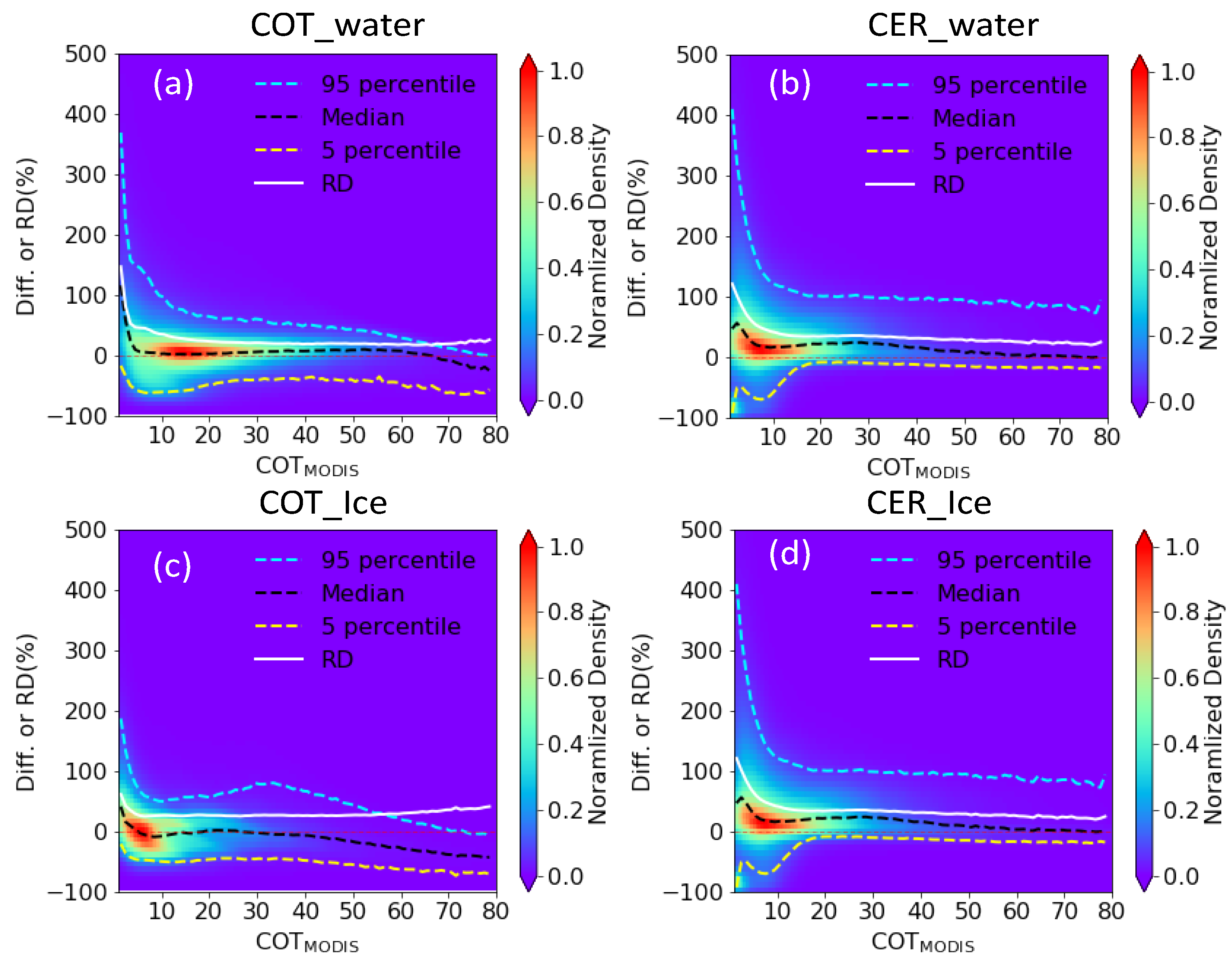
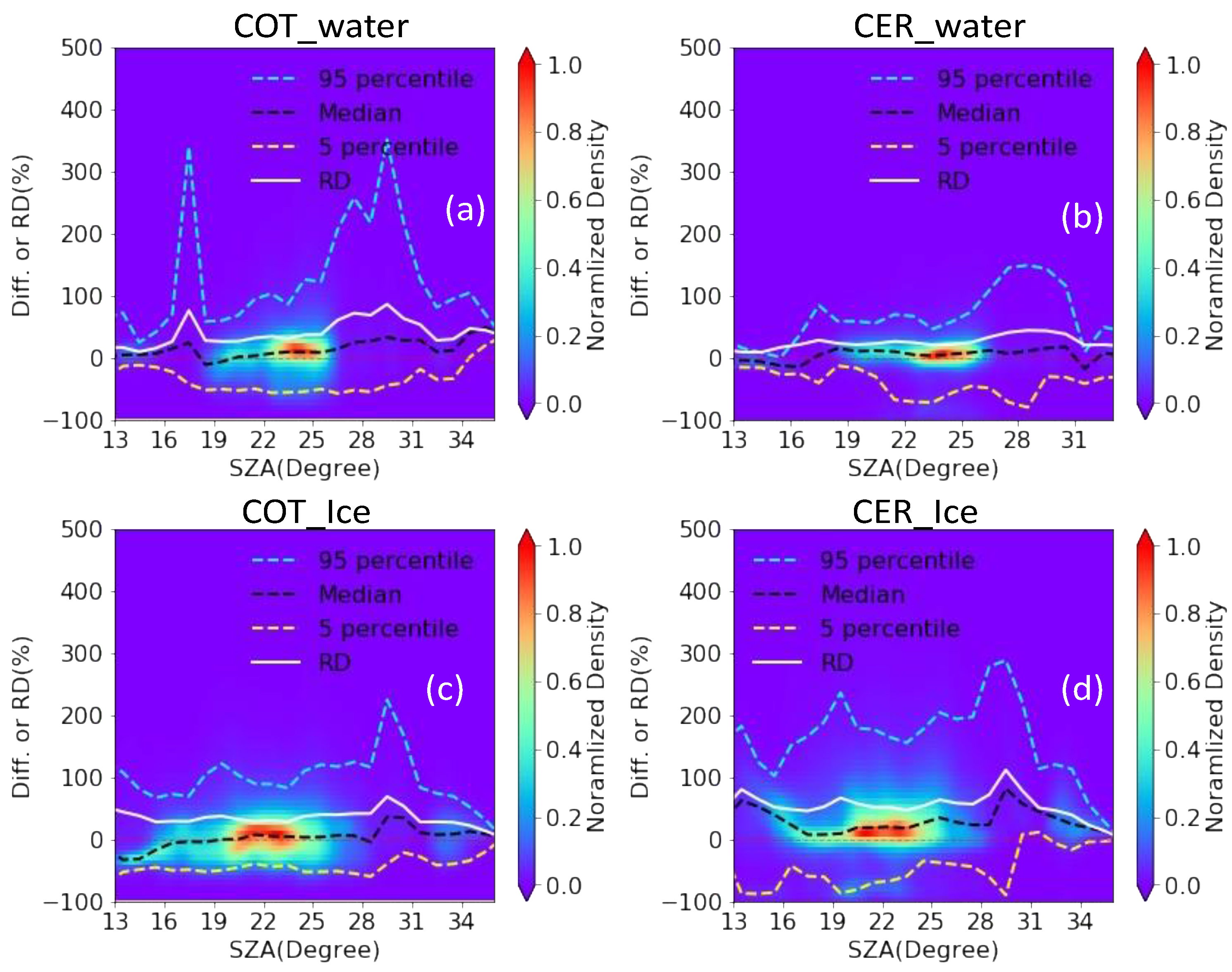
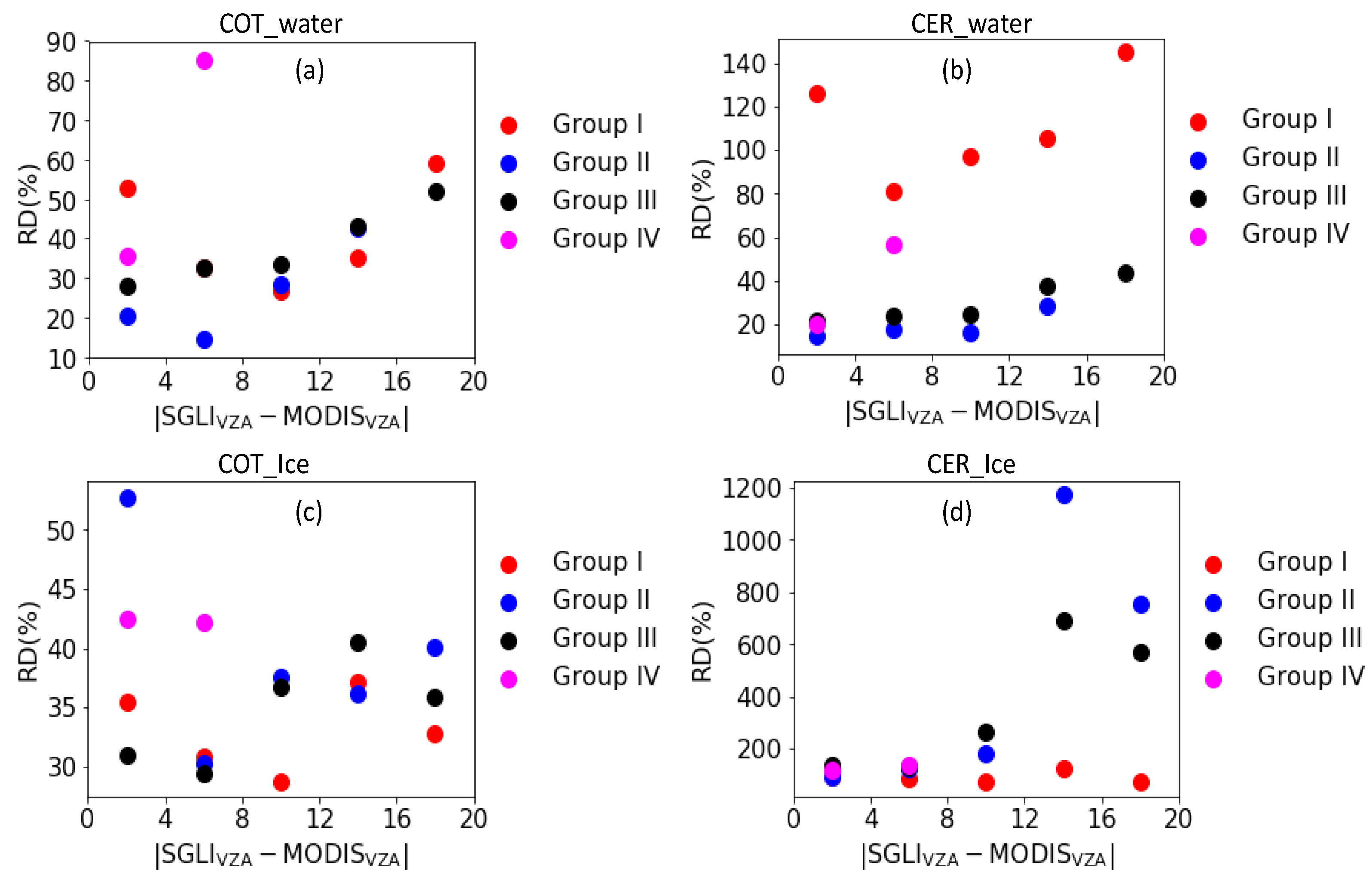
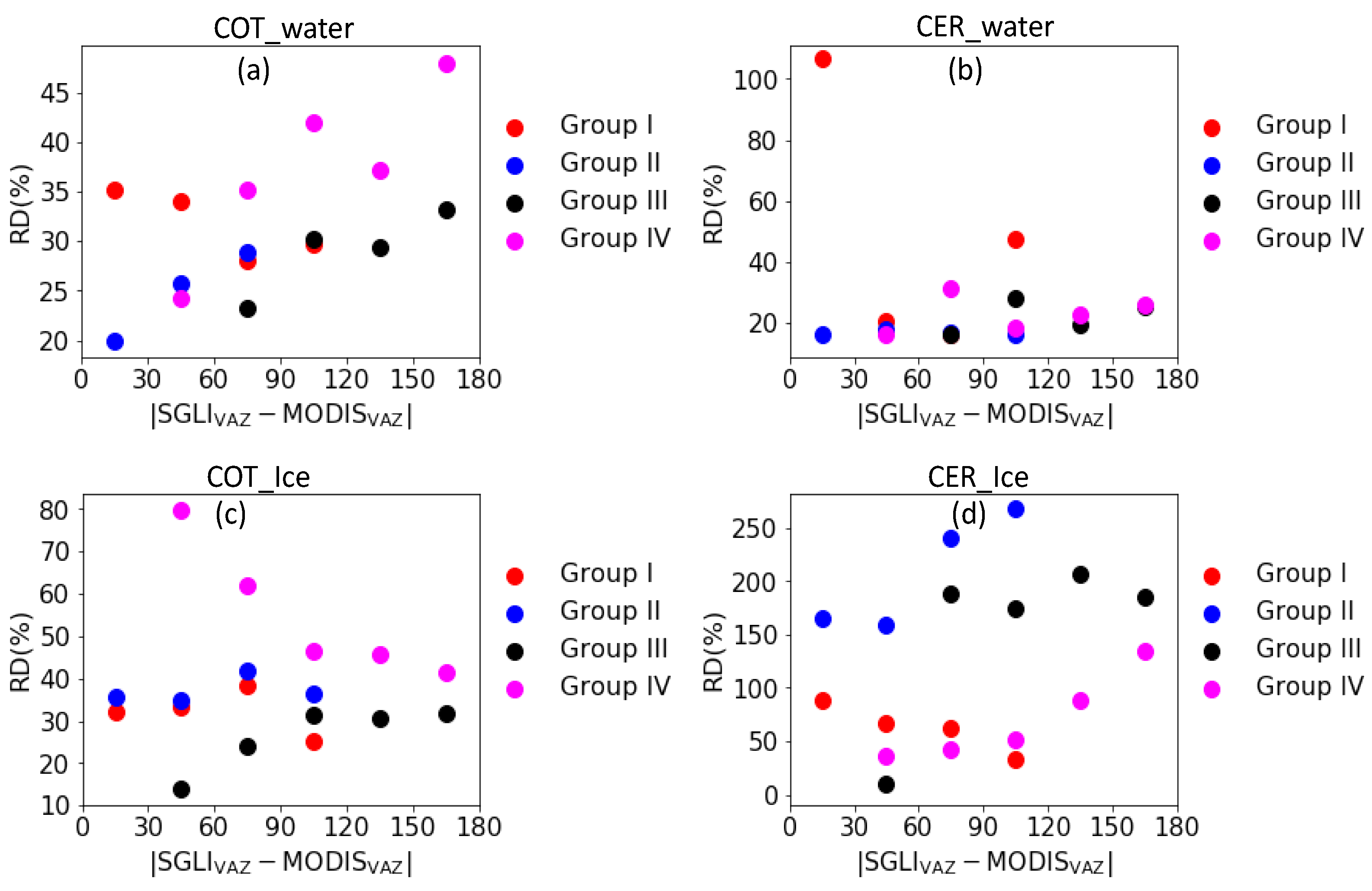
| MODIS | SGLI | |
|---|---|---|
| Product identification | Level 2.0 (Collection 6.1) | Level 2.0 (Version 3.0) |
| Wavelengths for retrievals of cloud properties | 0.66, 0.86, 1.24, 1.6, 2.1, and 3.7 μm | 1.05 and 2.21 μm |
| Wavelengths for detection of cloud phase | 7.3, 8.5, 11.0, 12.0 μm | 10.8 and 12.0 μm |
| Cloud-particle size distribution for retrieval of cloud properties | Gamma size distribution | Log-normal size distribution |
| Single-scattering properties for water clouds | Mie calculation | Mie calculation |
| Single-scattering properties for ice clouds | Severely roughened aggregated columns model | Voronoi model |
| SGLI Cloud Pixels | MODIS Cloud Pixels | |||
|---|---|---|---|---|
| Water Phase | Ice Phase | Mixed Phase | Undetermined | |
| Water phase (100%) | 92.1% | 3.2% | 0% | 4.7% |
| Ice phase (100%) | 23.5% | 58.1% | 0% | 18.4% |
| MODIS CER ≤ 20 μm | MODIS CER > 20 μm | |||
|---|---|---|---|---|
| Ocean | Land | Ocean | Land | |
| R_value | 0.43 | 0.28 | 0.23 | 0.31 |
| MBE | −7.25 μm | −15.49 μm | −1.34 μm | −9.18 μm |
| RMSE | 13.08 μm | 26.42 μm | 16.66 μm | 20.97 μm |
| RD | 77.0% | 137.0% | 33.0% | 37.0% |
| Comparison Metrics | Water Cloud Pixels | Ice Cloud Pixels | ||||||
|---|---|---|---|---|---|---|---|---|
| COT ≤ 10 | COT > 10 | COT ≤ 10 | COT > 10 | |||||
| COT | CER | COT | CER | COT | CER | COT | CER | |
| R-value | 0.41 | 0.53 | 0.78 | 0.61 | 0.69 | 0.38 | 0.68 | 0.51 |
| MBE | −1.17 | −0.79 μm | −0.57 | −0.49 μm | −0.44 | −13.78 μm | 1.26 | −6.66 μm |
| RMSE | 4.41 | 4.53 μm | 10.4 | 4.09 μm | 2.31 | 26.37 μm | 15.07 | 15.64 μm |
| RD | 60% | 25% | 28% | 22% | 41% | 78% | 26% | 36% |
Disclaimer/Publisher’s Note: The statements, opinions and data contained in all publications are solely those of the individual author(s) and contributor(s) and not of MDPI and/or the editor(s). MDPI and/or the editor(s) disclaim responsibility for any injury to people or property resulting from any ideas, methods, instructions or products referred to in the content. |
© 2023 by the authors. Licensee MDPI, Basel, Switzerland. This article is an open access article distributed under the terms and conditions of the Creative Commons Attribution (CC BY) license (https://creativecommons.org/licenses/by/4.0/).
Share and Cite
Khatri, P.; Hayasaka, T. Comparison of Cloud Properties between SGLI Aboard GCOM-C Satellite and MODIS Aboard Terra Satellite. Remote Sens. 2023, 15, 1075. https://doi.org/10.3390/rs15041075
Khatri P, Hayasaka T. Comparison of Cloud Properties between SGLI Aboard GCOM-C Satellite and MODIS Aboard Terra Satellite. Remote Sensing. 2023; 15(4):1075. https://doi.org/10.3390/rs15041075
Chicago/Turabian StyleKhatri, Pradeep, and Tadahiro Hayasaka. 2023. "Comparison of Cloud Properties between SGLI Aboard GCOM-C Satellite and MODIS Aboard Terra Satellite" Remote Sensing 15, no. 4: 1075. https://doi.org/10.3390/rs15041075
APA StyleKhatri, P., & Hayasaka, T. (2023). Comparison of Cloud Properties between SGLI Aboard GCOM-C Satellite and MODIS Aboard Terra Satellite. Remote Sensing, 15(4), 1075. https://doi.org/10.3390/rs15041075





